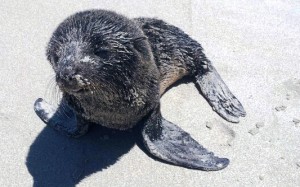
Today (15th Jan 2012) AMWRRO received information and photographs concerning 14 dead juvenile seals and 1 other still alive found amongst the dead on a small stretch of beach on the west coast of South Australia. A team of AMWRRO volunteers and members of the AMWRRO Scientific Board are leaving AMWRRO at 3am tomorrow to investigate and collect these animals for further post mortem examinations and to attempt to save the last seal pup (photo below).
A man and his son where heading to the popular fishing beach when they made the grim discovery and only managed to check approximately 500m of the beach; there are several small coves and other beaches close by that could reveal more dead animals.
Considering the geographical location of these animals; this could well be linked to “fishing bycatch” and or be associated to malicious activities e.g. shot, stabbed and or poisoned. More information will be provided in due time and flippers crossed we are able to save the poor soul awaiting help in and amongst the dead.
AMWRRO No Approach Zones”Safe Zones” for marine mammals and people whilst boating
Summer is definitely here and AMWRRO is receiving many calls from concerned people who are watching vessel operators approach too close to marine mammals (dolphins, seals and whales).
All vessel operators should know the following rules when out on the water and are either approaching or being approached by a marine mammal. These rules are just as much for your safety then that of the animal as some whales can weigh up to 30 tons and can cause serious injuries to you and your family or friends if upset or harassed (especially when young are near).
Seals
On land = a no approach zone of 30 metres
In water = 150 metre caution zone (4 knot maximum speed limit) with 50 metre no approach zone
Dolphins
150 metre caution zone (4 knot maximum speed limit) with 50 metre no approach zone
Whales
300 metre caution zone (4 knot maximum speed limit) with 150 metre no approach zone
“Assessment of injuries in marine mammals may be required to help authorities determine whether human activity was involved. Three cases of marine animal deaths involving propeller blade strikes are reported to demonstrate characteristic features of such cases and diagnostic difficulties that may occur.”
“Injuries from being struck by boat propellers are encountered in both human and animal populations1,2, the latter occurring more frequently as increasing numbers of boats either inadvertently or deliberately encroach upon sea mammal territory and/or intentionally approach too closely to marine mammals to facilitate observation. On occasion, forensic pathologists may be requested to examine traumatic lesions in marine mammals to help authorities determine whether human activity was involved, whether the injuries were sustained before or after death, and whether the injuries either caused or played a significant role in the animal’s death3. Three cases of marine animal deaths involving propeller blade strikes are reported to demonstrate characteristic features of such cases and diagnostic difficulties that may occur.”
Taken from: Byard RW, Winskog C, Machado A, Boardman W. The assessment of lethal propeller strike injuries in sea mammals. J Forensic Legal Med (In press).
Watch the full ABC News clipping for more information: http://www.abc.net.au/news/2011-12-02/forensic-procedures-uncover-marine-mysteries/3710378